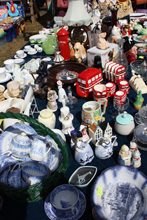Bric-à-brac
Decorative, not necessarily valuable, the term bric-à-brac was first used in the Victorian era, generally refers to lesser objet d'art forming collections of curios such as, for example, elaborately decorated teacups and small vases, porcelain figurines, painted miniatures or photographs in stand-up frames, and so on.
Bric-à-brac, household ornaments, bibelots (trinkets) and objet d'art in middle-class homes was used as ornaments on mantelpieces, cluttered tables and shelves or displayed in curio cabinets – sometimes with glass doors to display the items within while protecting them from dust. Bric-à-brac today may more refer to a selection of items of modest value, often sold in street markets. Source: wikipedia (edited).






